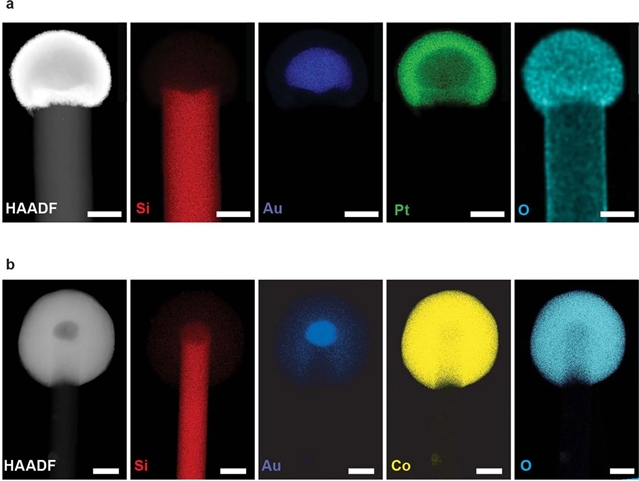
美国北卡罗来纳大学Cahoon, James F.团队报道了使用悬浮在溶液中的硅p–i–n超晶格裂解水。相关研究成果发表在2023年2月8日出版的《自然》。
光电化学(PEC)水裂解生产氢燃料是50年前首次报道的,但人工光合作用尚未成为一项广泛的技术。尽管平面硅太阳能电池已经成为一种普遍存在的电能源,在经济上与化石燃料相竞争,但尚未实现类似的PEC装置,并且标准的Si p型/n型(p–n)结不能用于水分裂,因为带隙阻碍了所需光电压的产生。另一种范例是颗粒悬浮反应器(PSR),它放弃了刚性设计,而是采用悬浮在溶液中的单个PEC颗粒,与平面系统相比,这是一种潜在的低成本选择。
该文中,研究人员通过合成被共功能化以催化分裂水的高光电压多结Si纳米线(SiNWs)报道了基于Si的PSR。通过在单个SiNW中编码p型-本征-n型(p–i–n)超晶格,在1个标准光照下观察到超过10V的可调谐光电压。氧和析氢共催化剂的空间选择性光电沉积使水在高达约1050nm的红外波长下分裂,氢生成的效率和光谱依赖性由亚波长直径SiNWs的光子特性决定。尽管初始能量转换效率较低,但多结SiNWs为PSR设计带来了可调谐的介观尺度几何结构的光子优势和Si的材料优势,包括小的带隙和规模经济性,为水分裂反应堆提供了一种新的方法。
附:英文原文
Title: Water splitting with silicon p–i–n superlattices suspended in solution
Author: Teitsworth, Taylor S., Hill, David J., Litvin, Samantha R., Ritchie, Earl T., Park, Jin-Sung, Custer, James P., Taggart, Aaron D., Bottum, Samuel R., Morley, Sarah E., Kim, Seokhyoung, McBride, James R., Atkin, Joanna M., Cahoon, James F.
Issue&Volume: 2023-02-08
Abstract: Photoelectrochemical (PEC) water splitting to produce hydrogen fuel was first reported 50 years ago1, yet artificial photosynthesis has not become a widespread technology. Although planar Si solar cells have become a ubiquitous electrical energy source economically competitive with fossil fuels, analogous PEC devices have not been realized, and standard Si p-type/n-type (p–n) junctions cannot be used for water splitting because the bandgap precludes the generation of the needed photovoltage. An alternative paradigm, the particle suspension reactor (PSR), forgoes the rigid design in favour of individual PEC particles suspended in solution, a potentially low-cost option compared with planar systems2,3. Here we report Si-based PSRs by synthesizing high-photovoltage multijunction Si nanowires (SiNWs) that are co-functionalized to catalytically split water. By encoding a p-type–intrinsic–n-type (p–i–n) superlattice within single SiNWs, tunable photovoltages exceeding 10V were observed under 1sun illumination. Spatioselective photoelectrodeposition of oxygen and hydrogen evolution co-catalysts enabled water splitting at infrared wavelengths up to approximately 1,050nm, with the efficiency and spectral dependence of hydrogen generation dictated by the photonic characteristics of the sub-wavelength-diameter SiNWs. Although initial energy conversion efficiencies are low, multijunction SiNWs bring the photonic advantages of a tunable, mesoscale geometry and the material advantages of Si—including the small bandgap and economies of scale—to the PSR design, providing a new approach for water-splitting reactors.
DOI: 10.1038/s41586-022-05549-5
Source: https://www.nature.com/articles/s41586-022-05549-5
官方网址:http://www.nature.com/
